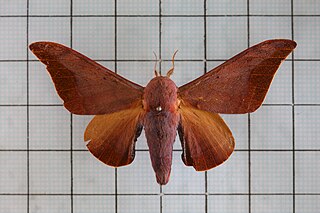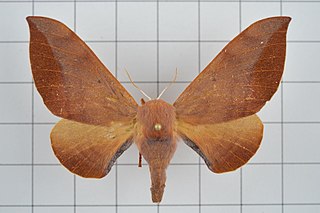
Andraca is a genus of moths of the family Endromidae.

Mustilia is a genus of moths of the Endromidae family. The genus was previously placed in the subfamily Prismostictinae of the Bombycidae family.

Mustilia sphingiformis gerontica is a subspecies of moth in the family Endromidae. It was first described by West in 1932. It is found in Taiwan.
Mustilia falcipennis is a moth in the family Endromidae first described by Francis Walker in 1865. It is found in India and Bhutan.
Mustilia phaeopera is a moth in the family Endromidae first described by George Hampson in 1910. It is found in Nepal and India.
Mustilia columbaris is a moth in the family Endromidae. It is found in India.

Mustilia sphingiformis is a moth in the family Endromidae first described by Frederic Moore in 1879. It is found in south-east Asia, including Vietnam, Myanmar, India and Bhutan.

Prismosticta fenestrata is a moth in the family Endromidae first described by Arthur Gardiner Butler in 1880. It is found in China, Taiwan, India and Nepal.
Mustilia craptalis is a moth in the family Endromidae. It was described by Vadim V. Zolotuhin in 2007. It is found in Yunnan, China.
Mustilia glabrata is a moth in the Endromidae family. It was described by Yang in 1995. It is found in China (Guangxi).
Mustilia semiravida is a moth in the Endromidae family. It was described by Yang in 1995. It is found in China (Guangxi).
Mustilia terminata is a moth in the Endromidae family. It was described by Yang in 1995. It is found in China (Guangxi).

Mustilizans hepatica is a moth in the family Endromidae. It was described by Frederic Moore in 1879. It is found in India, Thailand and Peninsular Malaysia.
Mustilia zolotuhini is a moth in the Endromidae family. It was described by Saldaitis and Ivinskis in 2015. It is found in China (Sichuan). The habitat consists of mixed mountain forests.
Mustilia attacina is a moth in the family Endromidae. It was described by Vadim V. Zolotuhin in 2007. It is found in Sichuan, China.
Mustilia tzarica is a moth in the family Endromidae. It was described by Vadim V. Zolotuhin in 2007. It is found in Thailand.
Mustilia ulliae is a moth in the family Endromidae. It was described by Vadim V. Zolotuhin in 2007. It is found in Shaanxi, China.

Apona fuliginosa is a moth in the family Eupterotidae. It was described by Yasunori Kishida in 1993. It is found in Taiwan.
Andraca yauichui is a moth of the Andraca genus of the Endromidae family that is endemic to Taiwan.







